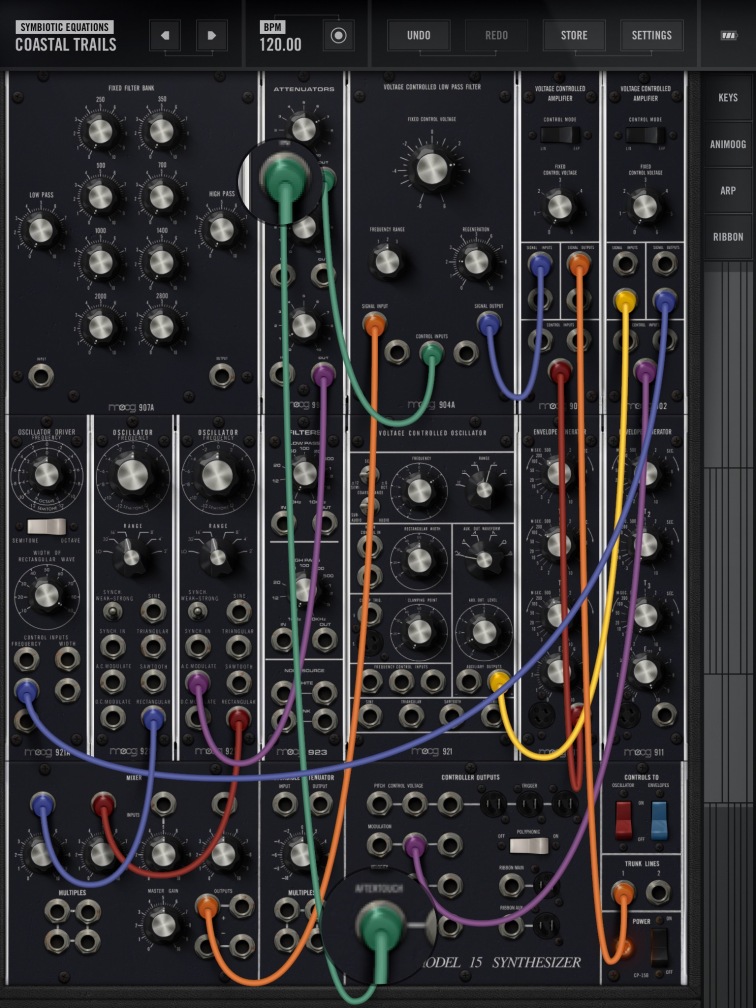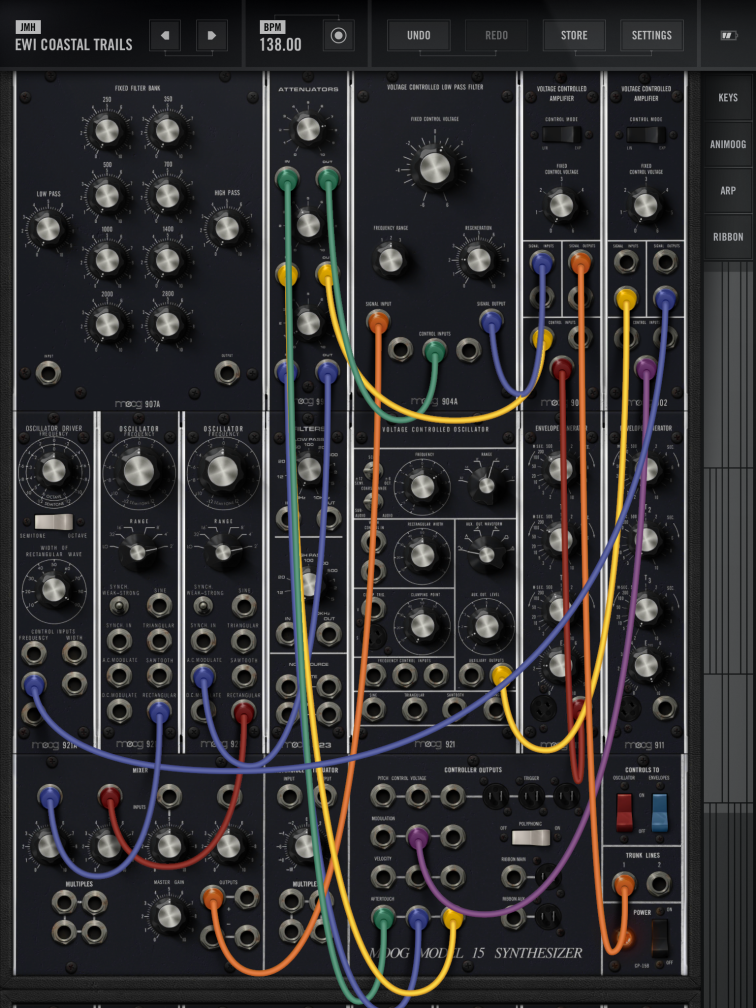I got the Moog Model 15 app for half price right after Thanksgiving. I especially wanted to try the aftertouch controls for use with my EWI wind controller.
Being a modular synth, the method of routing aftertouch is a very different experience from, say, iSem. In one way, it is more limiting in that there are only three direct aftertouch outputs (though this can be increased with the Multiplier modules), but since it is modular, it can be routed just about anywhere.
Model 15 can be a daunting app to get your arms around. Figuring out how all the modules work and how to connect them to “program” the sound you are after can be a long process, and so far, I have barely scratched the surface. So where to start in designing a breath controlled patch? Fortunately, you don’t have to start from scratch. The easiest way to get started is to pick a preset you like and tweak it for breath control. And some of the presets are already set up for aftertouch modulation, so those can be an even quicker jump off point. Let’s start with the “Coastal Trails” patch from the free Symbiotic Equations expansion pack.

I’ve magnified both ends of the green cable going from the Aftertouch output at the bottom up to the Attenuator input at the top. If you follow the other, shorter, green cable, it takes the output of the Attenuator and goes to the Control Input of the Voltage Controlled Low Pass Filter module. As I wrote in the iSem article, this is a common (almost ubiquitous) motif in programming synths for breath control – tie the filter to the breath. This means this patch is playable with the EWI right out of the box, but I wanted to add even more expression.
Here’s my tweaked patch.

Let’s look at the differences between this and the preset.
- Filter control – the green cables are the same, but note that the Attenuator knob is a little bit higher and the fixed control voltage of the filter is a good bit lower. This means the breath has a bigger effect on the filter and more breath is needed to fully open the filter.
- Tremolo – tracing the blue Aftertouch cable, it goes to the Attenuator with a small amount going to the A.C.Modulate socket of the second Oscillator module. I’m not sure why these sockets are labeled A.C. and D.C. It sounds like amplitude vs pitch modulation to me, meaning breath is giving a slight tremolo to the sound here. (Tip: in the category of “it’s a feature, not a bug”, it is worth noting that this cable from the Aftertouch module isn’t actually needed here due to a quirk of the Attenuator module. An input on one of the upper input sockets will be replicated to open sockets below it. That’s good in that a single Aftertouch output can control up to three Attenuator inputs this way, but it’s also the kind of thing that is easy to forget when trying to decipher how a patch works.)
- Volume – tracing the yellow cable, it again feeds the Attenuator but from there feeds one of the control inputs to the Voltage Controlled Amplifier which then feeds the trunk line, i.e. main output. So breath is controlling the volume along with the control input coming from the Envelope Generator module. This is a standard ADSR envelope except the labeling is weird. Top to bottom, the timing knobs (labeled T1, T2, T3) are attack, decay, and release with the sustain level on the bottom (labeled Esus). The difference in my patch is that the sustain level is quite low. The preset sustain level is all the way at 10, meaning there is nothing left for breath to do. With the level closer to 2, it means the bulk of the volume is coming from breath control, but there is still a little bit for the Release to work with. This gives the patch a smoother, almost legato feel.
- Range – the preset uses the 16′ setting but mine is 3 octaves higher with the 2′ setting. This lets me play closer to home position on the EWI to get to the range I wanted for my project.
What’s it sound like? Here are a couple of snippets. The first is the preset (with the delay effect turned off) played with the Animoog keyboard using the full vertical aftertouch range.
https://clyp.it/kivh30kn/widget
The second is my modified patch (again, with no delay effect), played the same way.
https://clyp.it/ekdg2xni/widget
Even from a small sample like this, it should be clear how much more control the second exhibits. In the first, the volume and filter are much more at the mercy of the ADSR envelope and fixed filter frequency.
Stay tuned for an upcoming project using this patch.
Great tutorial! Just got my EWI-USB working wirelessly with this hack: https://youtu.be/mmC41MeNc-Q. I have the Patchman M1 presets but looking for how to quickly roll my own wind patches.
LikeLike
Thanks Mike. That’s a neat trick with the EWI-USB. Good luck on your sound design journey.
Edit to add: oops, just realized we are SoundCloud “friends”. You’ve been on the journey for a while. Keep up the good work. 😛🤓👊🏻
LikeLike